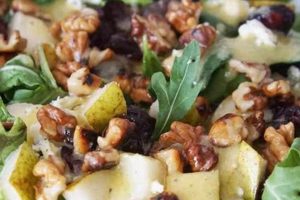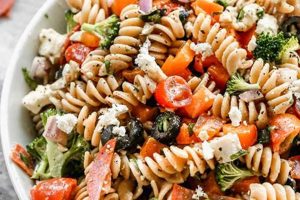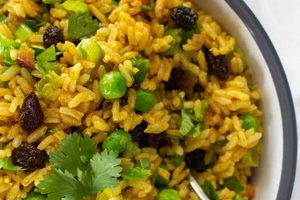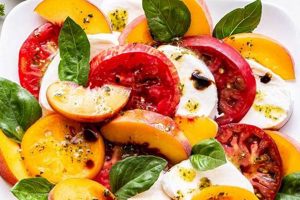Dishes categorized as cold salads from Mexico encompass a wide array of vibrant and flavorful options, typically featuring fresh produce, herbs, and often a light dressing or marinade. Common ingredients include corn, beans, tomatoes, avocados, onions, cilantro, and lime juice. Examples range from simple street corn salads (esquites) to more complex layered creations involving jicama, mango, or other tropical fruits. These preparations frequently incorporate chiles, offering varying levels of heat, and may also include proteins like grilled chicken or shrimp.
These refreshing salads are valued for their nutritional value, providing essential vitamins, minerals, and fiber. Their versatility makes them suitable for various occasions, from light lunches and side dishes to potlucks and festive gatherings. Historically, many of these dishes evolved from pre-Hispanic culinary traditions, incorporating indigenous ingredients and techniques later blended with European influences. The emphasis on fresh, readily available produce reflects a connection to the land and seasonal eating patterns.
Further exploration will examine specific regional variations, preparation methods, and the cultural significance of these culinary traditions. Nutritional information, ingredient sourcing tips, and suggestions for creative adaptations will also be discussed.
Tips for Crafting Exceptional Cold Salads Inspired by Mexican Cuisine
Achieving optimal flavor and texture in these dishes requires attention to detail and an understanding of key ingredients. The following tips offer guidance for creating vibrant and authentic cold salads.
Tip 1: Balance Flavors: Strive for a harmonious blend of sweet, sour, salty, and spicy elements. The acidity of lime juice complements the sweetness of corn or mango, while a touch of chili provides a welcome kick. Experiment with different chili varieties to achieve desired heat levels.
Tip 2: Embrace Fresh Herbs: Cilantro is a staple in many Mexican dishes, but other herbs like mint, oregano, and epazote can add depth and complexity. Incorporate herbs generously for a vibrant, fresh flavor.
Tip 3: Choose Quality Produce: The success of these salads hinges on the freshness of the ingredients. Select ripe, flavorful tomatoes, avocados, and other produce. Consider seasonal availability for optimal taste.
Tip 4: Proper Handling of Avocados: Prevent browning by adding avocados close to serving time or tossing them gently with a small amount of lime juice. This preserves their vibrant green color and prevents oxidation.
Tip 5: Toasting Spices: Toasting dried spices before grinding them enhances their flavor profile. This step is particularly beneficial for cumin, coriander, and ancho chiles.
Tip 6: Texture Variation: Combine a variety of textures for a more engaging culinary experience. Consider incorporating crunchy elements like toasted pepitas (pumpkin seeds) or jicama alongside softer ingredients like beans or cooked corn.
Tip 7: Marinating Time: Allow sufficient time for the flavors to meld. Marinating the salad for at least 30 minutes, or even overnight, allows the ingredients to absorb the dressing and develop a more complex flavor profile.
By following these guidelines, one can create cold salads that showcase the vibrant flavors and textures characteristic of Mexican cuisine. Experimentation with ingredients and flavor combinations is encouraged to develop unique and personalized variations.
This exploration of essential tips provides a foundation for crafting exceptional cold salads. The following section will delve into specific recipe examples, offering practical applications of these techniques.
1. Fresh Ingredients
The emphasis on fresh ingredients is paramount in Mexican cold salad recipes. These dishes derive their vibrant flavors and nutritional value from the quality of the produce used. Understanding the role of freshness is crucial for achieving authentic and satisfying results.
- Seasonality and Locality
Prioritizing seasonal and locally sourced produce ensures optimal flavor and supports sustainable agricultural practices. Tomatoes, corn, and avocados, when in season, offer superior taste and nutritional content. Local sourcing minimizes transportation time, preserving freshness and reducing environmental impact. This connection to the land and its bounty is a cornerstone of Mexican culinary tradition.
- Variety and Balance
Mexican cold salads celebrate a diverse range of fresh ingredients. The interplay of textures and flavors is essential. Crisp vegetables like jicama and radishes provide a refreshing contrast to creamy avocados and sweet mangoes. This balance creates a more complex and satisfying sensory experience.
- Herbs and Aromatics
Fresh herbs and aromatics are integral to the flavor profile of these salads. Cilantro, a staple in Mexican cuisine, provides a bright, citrusy note. Other herbs like oregano, mint, and epazote contribute distinct flavors and aromas, enhancing the overall complexity of the dish.
- Minimal Processing
Mexican cold salads often showcase ingredients in their natural state, minimizing processing and preserving their inherent nutritional value. Lightly blanching or grilling certain vegetables can enhance their flavor without compromising their freshness. This approach highlights the natural beauty and taste of the ingredients.
The reliance on fresh, high-quality ingredients distinguishes Mexican cold salads. This emphasis not only contributes to their vibrant flavors and textures but also reflects a deep appreciation for the natural world and its bounty. The careful selection and preparation of these ingredients are key to creating authentic and satisfying culinary experiences.
2. Vibrant Flavors
Vibrant flavors are a defining characteristic of Mexican cold salads, achieved through a complex interplay of ingredients and culinary techniques. This vibrancy stems from a careful balance of contrasting yet complementary taste profiles: sweet, sour, salty, spicy, and savory. The strategic use of fresh herbs, chiles, citrus, and spices contributes to this multi-layered sensory experience. For example, the sweetness of corn or mango is often balanced by the acidity of lime juice, while the heat of a serrano pepper is tempered by the earthiness of cumin or the coolness of cilantro. This dynamic interplay of flavors elevates these salads beyond simple refreshment, offering a complex and satisfying culinary experience.
The specific combination of flavors often reflects regional variations and cultural influences. Coastal regions might emphasize seafood and citrus, while inland areas might feature earthy flavors like corn, beans, and chiles. The use of specific chili varieties, like chipotle or habanero, further contributes to regional flavor profiles. These nuances highlight the diversity and richness of Mexican culinary traditions, demonstrating how vibrant flavors can express regional identity and cultural heritage within the context of a single dish type.
Achieving these vibrant flavor profiles requires an understanding of ingredient interactions and the impact of preparation techniques. Roasting tomatoes deepens their sweetness, while toasting spices enhances their aromatic complexity. Marinating allows flavors to meld and intensify over time. The skillful application of these techniques is crucial for creating truly exceptional Mexican cold salads, transforming simple ingredients into a harmonious and vibrant culinary creation. Mastery of these techniques allows for adaptation and customization, empowering individuals to explore and create their own unique flavor combinations while staying true to the fundamental principles of Mexican cuisine.
3. Varied Textures
Textural diversity is a key element in Mexican cold salads, contributing significantly to the overall sensory experience. The interplay of contrasting texturescrunchy, creamy, smooth, firmelevates these dishes beyond simple sustenance, creating a more engaging and satisfying meal. A well-composed salad offers a dynamic interplay that stimulates the palate and enhances enjoyment.
- Crunchy Elements
Crunchy components provide a satisfying contrast to softer ingredients. Examples include toasted pepitas (pumpkin seeds), jicama, tortilla strips, or chopped romaine lettuce. These elements contribute a textural counterpoint, preventing the salad from becoming monotonous and adding a delightful element of surprise with each bite.
- Creamy Components
Creamy textures often come from avocados, queso fresco, or a light dressing. These elements provide a richness and smoothness that complements the crunchier components. Avocados, in particular, offer a healthy source of fat and contribute a luxurious mouthfeel.
- Firm Elements
Ingredients like cooked corn kernels, beans, or grilled vegetables offer a firmer texture, providing a substantial bite. These elements contribute to the heartiness of the salad and offer a textural contrast to both crunchy and creamy components.
- Juicy Elements
Juicy components, such as tomatoes, oranges, or mangoes, introduce bursts of flavor and moisture. These elements contribute to the overall freshness and vibrancy of the salad, balancing the other textures and preventing the dish from feeling dry.
The strategic combination of these varied textures creates a dynamic and engaging culinary experience. This interplay of textures not only enhances the enjoyment of the salad but also reflects a sophisticated understanding of culinary principles. The balance of textures, combined with the vibrant flavors and fresh ingredients, distinguishes Mexican cold salads as a truly unique and satisfying culinary tradition.
4. Simple Preparation
The ease of preparation is a hallmark of many Mexican cold salad recipes. This characteristic contributes to their popularity for everyday meals, picnics, and potlucks. Minimal cooking, often limited to grilling or blanching certain vegetables, ensures quick assembly. This simplicity does not compromise flavor or nutritional value, allowing the fresh ingredients to shine. The focus shifts to skillful ingredient selection and preparation rather than complex culinary techniques.
- Emphasis on Fresh Produce
The reliance on fresh, readily available ingredients simplifies the preparation process. Washing, chopping, and combining fresh produce constitutes a significant portion of the preparation. This emphasis on fresh ingredients reduces the need for extensive cooking or processing, streamlining the overall effort and preserving the natural flavors and nutrients of the components.
- Minimal Cooking Requirements
Many Mexican cold salads require little to no cooking. Grilling corn or blanching vegetables enhances their flavor but remains optional in many recipes. This minimal heat application preserves the fresh, vibrant qualities of the ingredients while simplifying and accelerating the preparation process. This allows cooks to focus on the quality and combination of ingredients rather than complex cooking procedures.
- Versatile Flavor Combinations
Simple dressings and flavor combinations contribute to the ease of preparation. A basic vinaigrette of lime juice, olive oil, and spices often suffices, eliminating the need for elaborate sauces. The inherent flavors of the fresh ingredients are allowed to take center stage, showcasing the natural synergy of Mexican culinary staples.
- Adaptability and Improvisation
Mexican cold salad recipes lend themselves to adaptation and improvisation. Ingredient substitutions based on availability or preference are easily accommodated. This flexibility simplifies the preparation process, allowing cooks to utilize readily available ingredients without sacrificing flavor or authenticity. This adaptability makes these recipes accessible to a wide range of skill levels and culinary preferences.
The simplicity of preparation inherent in many Mexican cold salad recipes enhances their appeal for various occasions. This ease of assembly, combined with the vibrant flavors and nutritional value, makes these dishes a practical and satisfying choice for both everyday meals and festive gatherings. The focus on fresh ingredients and minimal cooking allows the natural flavors to shine, showcasing the essence of Mexican culinary traditions in a refreshingly accessible format.
5. Healthy Options
Mexican cold salads offer numerous health benefits, deriving primarily from their reliance on fresh, unprocessed ingredients. These dishes frequently feature nutrient-rich vegetables like tomatoes, avocados, corn, and beans, providing essential vitamins, minerals, and dietary fiber. Avocados contribute healthy fats, while beans offer plant-based protein and fiber, promoting satiety and digestive health. The emphasis on fresh produce maximizes the intake of antioxidants, linked to reduced risk of chronic diseases. Furthermore, the light dressings typically used in these salads, often based on lime juice and olive oil, avoid the excess calories and unhealthy fats found in many other salad dressings. This combination of nutrient-dense ingredients and light preparation methods contributes to the overall healthfulness of Mexican cold salads, making them a suitable choice for health-conscious individuals.
Specific examples illustrate the nutritional advantages. A salad featuring black beans, corn, bell peppers, and tomatoes provides a substantial dose of fiber, vitamin C, and antioxidants. The addition of avocado further enhances the nutritional profile with healthy fats and vitamin E. Choosing whole-grain tortilla strips over fried options adds fiber and reduces unhealthy fats. These salads can be further enhanced with lean protein sources like grilled chicken or fish, creating a complete and balanced meal. Such combinations offer a flavorful and convenient way to incorporate a variety of essential nutrients into one’s diet, supporting overall well-being. The adaptability of these recipes allows for customization based on individual dietary needs and preferences, making it easy to create a healthy and satisfying meal.
Incorporating Mexican cold salads into a regular diet can contribute to a healthier lifestyle. Their nutrient density, combined with their refreshing nature and ease of preparation, makes them a practical and appealing option for individuals seeking to improve their dietary habits. These salads offer a flavorful and versatile alternative to less healthy meal choices, promoting increased consumption of fruits and vegetables. Understanding the nutritional value of these dishes empowers informed choices, supporting long-term health and well-being by integrating readily available, nutrient-rich ingredients into everyday meals. This awareness facilitates the development of sustainable dietary patterns aligned with individual health goals and preferences.
6. Cultural Significance
Mexican cold salads possess significant cultural relevance, extending beyond mere sustenance to embody traditions, regional identities, and historical narratives. These dishes represent a tangible link to Mexico’s rich culinary heritage, reflecting indigenous practices, agricultural cycles, and the evolution of culinary techniques over time. Specific ingredients carry cultural weight, symbolizing agricultural abundance or regional specialties. For instance, corn, a staple in Mexican cuisine, holds deep historical and spiritual significance, representing life, sustenance, and cultural identity. Its presence in numerous cold salads underscores its central role in Mexican culinary traditions.
Regional variations in these salads further highlight their cultural significance. Coastal regions often incorporate seafood, reflecting the local fishing industry and culinary traditions. Inland areas might feature ingredients like nopales (cactus pads), showcasing the resourcefulness and adaptability of Mexican cuisine in utilizing indigenous ingredients. These regional adaptations not only diversify the culinary landscape but also preserve distinct cultural identities. Festivals and celebrations often feature specific cold salads, reinforcing their cultural importance within communal gatherings and traditional practices. For example, during Da de los Muertos (Day of the Dead), certain salads might be prepared as offerings or consumed as part of the celebratory meal, connecting food with cultural memory and ancestral reverence.
Understanding the cultural significance of Mexican cold salads enriches the culinary experience, adding a layer of appreciation beyond taste and texture. Recognizing the historical and cultural context of these dishes provides a deeper understanding of Mexican culinary traditions and their ongoing evolution. This awareness fosters respect for cultural diversity and promotes the preservation of culinary heritage. It enables a more meaningful engagement with Mexican cuisine, appreciating the cultural narratives embedded within each dish. Furthermore, recognizing these connections allows for a more informed and respectful approach to adapting and innovating within this culinary tradition, ensuring that modifications honor the cultural heritage while embracing culinary creativity.
Frequently Asked Questions about Mexican-Inspired Cold Salads
This section addresses common inquiries regarding the preparation, ingredients, and cultural context of Mexican-inspired cold salads.
Question 1: What distinguishes Mexican-inspired cold salads from other salad types?
Mexican-inspired cold salads typically emphasize fresh produce, vibrant flavors derived from chiles, citrus, and herbs, and a balance of textures. They often incorporate ingredients native to Mexico, such as jicama, nopales, and various types of chiles, distinguishing them from salads of other culinary traditions.
Question 2: Can canned ingredients be used in these salads?
While fresh ingredients are preferred for optimal flavor and texture, canned beans and corn can be substituted in certain recipes. Thorough rinsing is recommended to remove excess sodium. However, using fresh produce whenever possible is generally advised for a more authentic and flavorful result.
Question 3: How can spice levels be adjusted in these recipes?
Spice levels can be easily adjusted by modifying the type and quantity of chiles used. Removing seeds and membranes from chiles reduces heat significantly. Starting with milder varieties like poblanos and gradually increasing heat with jalapeos or serranos allows for controlled customization.
Question 4: Are there vegetarian/vegan adaptations for these salads?
Many Mexican-inspired cold salads are inherently vegetarian or easily adapted for vegan diets. Omitting cheese or substituting vegan cheese alternatives accommodates vegan preferences. Ensuring other ingredients, such as dressings, are free of animal products maintains vegan integrity.
Question 5: What are common serving suggestions for these salads?
These salads are versatile and can be served as standalone light meals, side dishes accompanying grilled meats or fish, or components of larger buffets. They also pair well with traditional Mexican accompaniments like tortilla chips or tostadas.
Question 6: How can these recipes be adapted for different seasons?
Adapting recipes to seasonal produce maximizes flavor and nutritional value. Substituting in-season fruits and vegetables, such as winter citrus or summer melons, allows for year-round enjoyment while adhering to the principles of fresh, vibrant ingredients characteristic of Mexican cuisine.
Understanding these common points of inquiry clarifies key aspects of preparing and enjoying Mexican-inspired cold salads, enabling a more informed and rewarding culinary experience.
The following section will provide specific recipe examples demonstrating the practical application of these principles.
Mexican Cold Salad Recipes
This exploration of Mexican cold salad recipes has highlighted their diverse nature, emphasizing the importance of fresh ingredients, vibrant flavor profiles, varied textures, and simple preparation methods. The cultural significance of these dishes, reflecting regional variations and historical traditions, has been examined, alongside their nutritional benefits derived from the abundance of fresh produce and lean proteins. The ease of adaptation and customization makes these salads suitable for various occasions and dietary preferences.
Mexican cold salad recipes offer a vibrant and accessible entry point into a rich culinary heritage. Further exploration and experimentation with regional variations and ingredient combinations promise a rewarding culinary journey. The continued appreciation and adaptation of these dishes ensure the preservation and evolution of a vibrant culinary tradition, offering both nourishment and a connection to a rich cultural tapestry.






